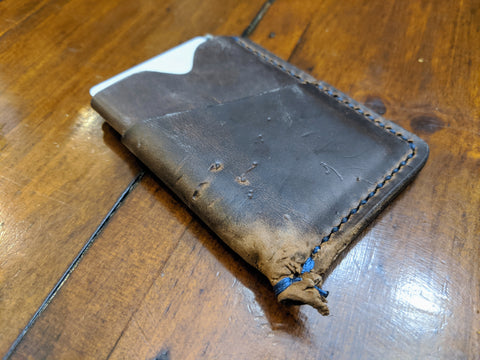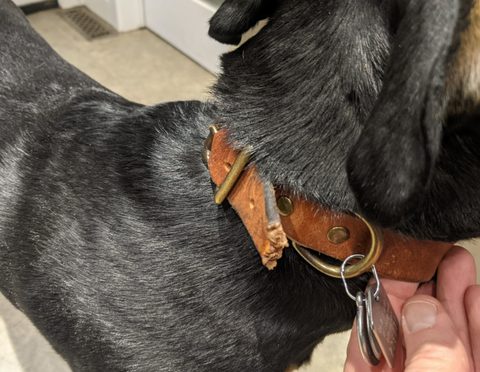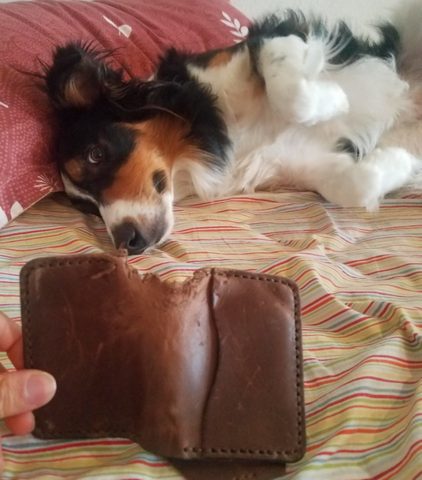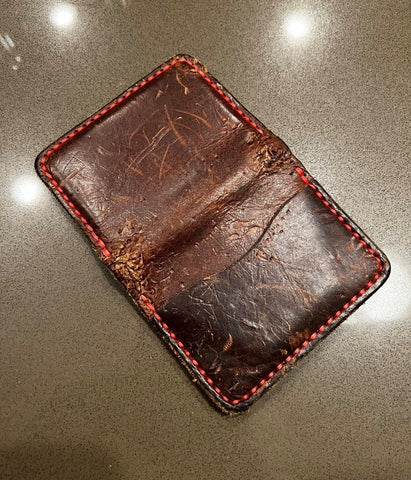Recently, we’ve received numerous reports from our customers that their dogs have chewed through their leather wallets.
What can we say? Something about the smell of genuine leather seems to be as irresistible to our furry friends as it is to the rest of us.
Still, when you invest money in handmade leather wallets, or sink sentimental value into beautiful engraved wallets, the last thing you want is for your investment to wind up in your buddy’s stomach. And let’s be honest: as beautiful as they are, quality leather wallets aren’t meant to line your pup’s stomach.
So how can you prevent your dog from eating leather wallets? And if your dog does get a hold of your wallet, what should your next step be? In this guide, we outline everything you need to know.

Why do dogs eat leather wallets?
There are a number of reasons your dog may be attracted to gnawing on your leather wallet.
For one thing, the smell of genuine leather is enticing to them. Although domestic dogs have been out of the wild for a long time, their genetic code is still similar to that of wild dogs. So it’s no surprise that they’d find the beautiful, earthy scent of all-natural leather appealing to their senses.
Leather is also an interesting texture for many dogs. The thickness of the material can give them an alluring sensation. This is especially true when dogs are teething and prone to chewing everything within sight. Leather can feel good on their sensitive gums. The size of a typical leather wallet — small enough to fit in their mouths, but large enough not to be swallowed in one go — makes them appear, to your dog, to be particularly seductive chew toys.

What are the risks to dogs eating handmade leather wallets?
First, breathe a sigh of relief: leather itself is not poisonous to dogs. So if your dog has just chewed through your leather product, and hasn’t consumed much of it, there’s little to no risk (except for the risk to your poor wallet).
However, if your dog has eaten a large chunk out of your leather wallet, it’s important to pay close attention. Your dog’s digestive system is not equipped to break down leather, so if the amount they consumed is too large to pass through their body, they would be at risk of an obstruction.

Symptoms of leather obstructions in dogs
If you’re not sure how much leather your dog ate, your best bet may be to observe their behavior over the next couple of days. Symptoms that your dog may have a leather obstruction include:
- Pain / Whimpering
- Vomiting
- Weakness / Lethargic behavior
- Loss of appetite
- Constipation
If you believe your dog may be at risk of a leather obstruction, call your vet for next steps. Typically, the vet will order an X-ray of your dog to confirm the obstruction and determine its location. At that point, they would discuss with you whether your dog would need laparoscopic surgery or a more invasive surgical procedure.
What should you do if your dog is prone to eating leather goods?
Of course, leather wallets aren’t the only genuine leather items your dog may be attracted to. Chances are, if they enjoy chewing on leather wallets, they’ll soon be after leather shoes, purses, and even their own leather dog leash. That’s why it’s important to have a process to prevent your dog from eating leather items and encourage them to chew other objects instead.

Giving your dog other options
One of the first things you should do, if your dog starts chewing through your good leather, is evaluate what their other options for chew toys are. Chewing provides a number of benefits to dogs. For young dogs, it can provide sensory relief while teething, while older dogs use chewing to strengthen their jaws and even clear their teeth.
So, if your dog has started chewing through objects in the house, it may be a sign that their current chew toys are no longer providing enough oral stimulation for their needs. Look for other options for your dog, including:
- Inedible bones
- Ropes
- Chew toys
- Treat puzzles
Even if you have plenty of chew toys in your home, your dog may become bored if things have stayed the same for too long. For this reason, it can be a good idea to have dog toys on a 3-4 day rotation cycle so things stay fresh.

Evaluate their diet
Leather is a common choice for destructive chewing when dogs are on a calorie-restricted diet because of its resemblance to meat. So, if your dog has started chewing leather for the first time, it may be a sign that they’re hungry.
This can happen if your puppy is going through a growth spurt and suddenly requires more nutrients to get through the day. If this is the case, simply upping the amount of food you offer them may resolve your problem.

On the other hand, you may have needed to put your dog on a more restrictive diet to combat canine obesity. Approximately 56% of dogs are either overweight or obese. And just like with humans, obesity in dogs can have a negative impact on their overall health and wellness. The risks of just a few pounds of extra weight on a dog can include:
- Joint pain and deterioration
- Kidney damage
- High blood pressure
- Increased risk of cancer
Obviously, with those risks on the table, you can’t simply abolish your dog’s calorie-restricted diet when they start chewing on items in your house. Instead, you may need to deal with their destructive eating in the same ways you’d deal with food cravings with a human struggling with food addiction. This may include:
- Keeping your dog distracted by taking them on more frequent walks or playing with them more often
- Offering a little extra water throughout the day so they can put something in their belly
- Providing things like bones to give them the oral stimulation they crave
Ultimately, however, if you’re in the process of cutting down your dog’s calorie intake, time is going to be the most important factor to success. Just as with humans, your dog will initially respond with increased hunger, but over time, that hunger will subside and they’ll become accustomed to their new diet.

Providing your dog with extra attention
Whether your dog is struggling with a new, calorie-restrictive diet or they’re having another issue — such as separation anxiety or frustration with a new life change — leading to their destructive chewing, receiving more attention from you can only serve to help them combat this new habit.
Be sure to provide your dog with plenty of exercise during this period of time. This can include taking walks, going to a doggy training area, or just wrestling a bit indoors.
Dogs also require social stimulation throughout the day. When possible, invite friends over or bring your dog to a pet-friendly location where they can socialize with other pets. Structured training with you and your dog can also help you both address this new chewing behavior.
Doggy daycares have cropped up around the world to help pet-owners address this important need. If you find that your dog chews up your house when you’re not home — or on days you’ve been out of the house for a long period of time — you may consider enrolling them in a daycare program a few times a week so they can receive the exercise, attention, and socialization they crave throughout the day.

Protecting your leather wallets and other items
Of course, even if you do everything correctly, there’s a chance your dog will go after your genuine leather wallets or other leather products in your home. That’s why, in addition to the steps listed above, it’s a good idea to take preventative measures to keep your dog from chewing your leather.
Set your dog up for success by putting leather items away in closets or up on high shelves as much as possible. This reduces the temptation for your dog to engage in destructive chewing behaviors.
And if there’s one particular item your dog seems to gravitate toward again and again, you can use something like a pet-safe bitter apple spray to make the item unappealing to your dog.
It’s also important to have a planned response for what to do when your dog eats something they shouldn’t. Practices like tying their mouth shut around the item are not only outdated, but actually inhumane, and have been known to cause dogs to die.
Instead, when you see a dog going for an item they shouldn’t have, say “no” calmly but firmly, and then offer them a pet-friendly item to chew instead. Over time, they’ll learn which items they can and cannot eat.
You can help this process along by ensuring that none of their chew toys resemble items you don’t want them to eat. For example, if you don’t want your dogs eating your shoes, don’t buy chew toys that look like shoes. Doing so can be confusing for your dog.
Protect your pups AND your leather products
There are a lot of things to love about high-quality leather wallets. Unfortunately, your dog may feel the same way. To protect your pup and your genuine leather goods, keep quality leather items out of your dog’s reach, and ensure that you’re providing proper mental, physical, and sensory stimulation for your dog throughout the day. If destructive chewing continues to be a problem, consider attending training with your dog to learn more about addressing these behaviors.
Junyuan Bags | Professional Bag Manufacturer
Ten articles before and after
What Is Suede, Is It Leather, and How Is It Different? – Junyuan Bags
What Is Top Grain Leather? Top Grain vs. Full Grain Leather Full Break – Junyuan Bags
Is Leather Waterproof? Our Complete Guide On Leather and Water – Junyuan Bags
How to Choose the Best Leather Wallets for Women – Junyuan Bags
Where To Find Your MacBook Pro Model Number and Why You Might Need To – Junyuan Bags
What Is PU Leather? A Head to Head Comparison With Full Grain Leather – Junyuan Bags
The RFID Blocking Card: Here’s What You Need to Know – Junyuan Bags
What Is Bonded Leather: The Most Important Things To Know – Junyuan Bags
What Actually Is Faux Leather and How Does It Compare To Real Leather? – Junyuan Bags
How to Get Into Leatherworking with Your Kids – Junyuan Bags




 Mobile/What's App/Wechat
Mobile/What's App/Wechat E-Mail
E-Mail ADD
ADD




